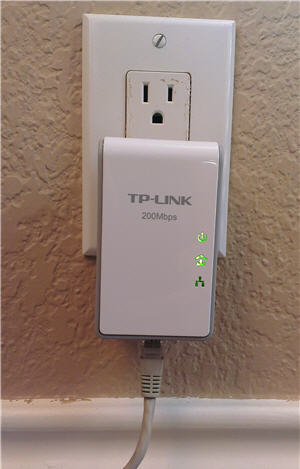Powerline Ethernet Faster & More Reliable Than WiFi

TP-LINK Powerline Ethernet adapters can save you time and money. Running an ethernet cable to a room or location after construction can be doable, a nightmare or impossible.
It’s never “easy”.
Since time is money, you have to consider that when deciding to pull cable in walls – risk a hole where is doesn’t belong – or simply go with an alternative.
Naturally, WiFi comes to everyone’s mind but I have spent way to many hours trying to make a USB WiFi adapter work or get the right drivers to load for an add-in WiFi card for a desktop and that’s AFTER you had to open it up just to see what kind of slot was available and buy the right kind.
Other Problems With WiFi
Ever had a “dead spot” with WiFi?
Ever tried to make a WiFi extender work? How about a booster? Buy a better antenna; buy a more expensive WiFi router advertised to “go farther and eliminate dead spots” only to have connection problems?
Trouble shooting WiFi can be a career all on its own, but I don’t recommend it because the stress is too high and you may end up with the same success (and admiration) of a local weather forecaster.
My policy has always been: Go with a cable whenever you can.
And while I crawled in some tight places running Category 5 or 6 cable to rooms that needed a first or more ports available, most every home and building has electrical wiring that will easily support a reliable powerline ethernet connection that is faster than a WiFi signal.
TP-LINK powerline adapter starter kits are ridiculously cheap considering what they will do for you and how well they work.
I tried this brand after video guru Bill Myers recommended it and said his worked flawlessly. Since I had an application in mind I figured, why not?
Turns out it was every bit as simple as it’s supposed to be.
Plug in each TP-LINK powerline adapter unit into the wall outlet (NOT a surge protector), connect the device with an ethernet cable and connect the other powerline adapter to a port on a switch or router and you are in business.
In this case, I was connecting a desktop unit and there were 2 reasons I didn’t want to go WiFi:
- This workstation was going to be transferring lots of HD photos and multi-gigabyte video files, so WiFi speed would just be inadequate.
- With a desktop PC I had no desire to try to make an internal WiFi adapter work nor do I want to mess with one of those USB WiFi adapters again unless someone is paying me well for my time!
The TP-LINK powerline was quick and it’s many times faster than WiFi. It just works.
You need a starter kit of 2 to get it going; after that you can add a single unit to expand.
Check it out – TP-LINK TL-PA2010KIT AV200 Nano Powerline Adapter Starter Kit, up to 200Mbps
A TP-Link system is a great idea. Saves pulling network cables all around the house and hoping that you can catch a passing Wi-Fi signal!
How do they compare to more traditional systems regarding speed?
Depends on which one you buy, they have more than one speed now. The slowest is probably double the speed of GOOD WiFi, the best is still gonna be slower than a dedicated gigabit cable.
Ok, so I am a little confused on how this works. Just so you know… I am not the sharpest tool in the shed…lol So you connect one of these adapters in an electrical outlet at the incoming internet modem and another you plug near your desktop computer and connect it to the ethernet port?
If it’s that easy, then why did I spend all that time running internet cable to just about every room in the house and to the shop? lol Oh I know, because we are remodeling the house anyways! Great article, Roger.
Wow, I never knew you could do that. I am not a fan of WiFi and this offers such a simple solution. Thanks, what a great idea!
Handy tool for when wifi is not working properly, great through put also better that wifi as you say transferring HD images etc. Great info thanks!